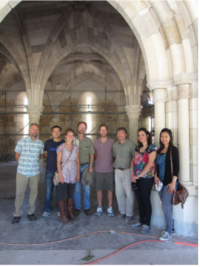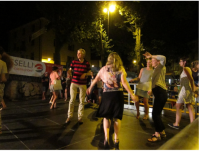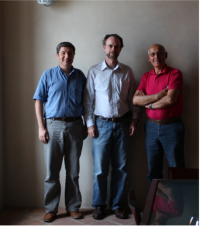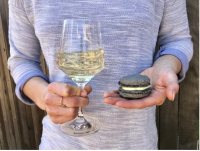I was very lucky that in 1990, I saw an ad for a job at UC Davis. The next year I was proud to join such a distinguished department with its long history of leadership in research and teaching in Viticulture and Enology. In my first quarter as a faculty member, Professor Ough asked me to give a lecture on chromatography. I was happily explaining how HPLC could separate and quantify the acids in wine when a student innocently asked, “how much tartaric acid is in wine?” I had no idea, and I realized how much I needed to learn. To get up to speed, I attended all the enology classes that first year, becoming a student as well.
I inherited Professor Vern Singleton’s lab and office, and immediately dove into the complex world of phenolics. In short order, phenolics were in the limelight because Professor Creasy at Cornell suggested that resveratrol was responsible for the French Paradox. Pierre-Louis Teissedre and I teamed up with a group on campus to synthesize resveratrol and to measure the antioxidant properties of wines and their phenolic constituents. Our later work involved many others and moved on to the metabolism of phenolics; Sarah Forester and Ying Choy investigated the presence of these compounds in urine and even pig poop. In one of our fun projects, Joe Shirley and Jennifer Donovan showed that chocolate phenolics were a potent source of antioxidants, much to the joy of chocolate consumers.
One of the threads on phenolics was Jim Kennedy’s work that looked at how different vineyard sites produced varying phenolic profiles, and how irrigation affected those compounds. Later, Alex Chassy elucidated the pathway for the fate of the grape pigments in the berry, and James Campbell showed that once winemaking begins, those pigments react with tannin much faster than previously thought. Alejandro Zimman was lucky to work with a number of wineries studying different maceration techniques at production scale, and their effect on phenolic extraction. Based on our results, some changed their production practices during the experiment! In a later collaboration with chemists at UC Davis and in Germany, Jonathan Cave showed the diversity of wine tannin using MS techniques that may someday be used by winemakers. In a long running project, Rosa Lamuela and I were frustrated in trying to identify the pink substance in pinking. Its unpredictable and sporadic occurrence combined with its transient nature has made it an elusive target.
At the end of the wine chemistry class many years ago, Alice Sprouse mentioned that she had hoped to learn more about wine oxidation. That led to a sabbatical leave to study oxidation chemistry with Paul Kilmartin in beautiful New Zealand. When I returned, Willy Joslin, the Wente winemaker, helped Felipe Laurie and me set up large scale micro-ox experiments. Those trials opened the door to studying wine oxidation, leading to many additional experiments conducted over the years by over 10 students and others, including Lingjun Ma’s analysis of the flavonoid oxidation pathway, and the importance of iron species that Thi Nguyen demonstrated.
Training the next generation of scientists involves more than scientific theories. Over two decades my research team was supported and managed by Mauri Anderson. She taught countless students to use the spectrophotometer, the HPLC, and so many other lab gadgets. She had keen insight into student morale, as research could be frustrating and difficult. We often discussed how to motivate and guide the discouraged researcher and get them back on track. Our students truly are our most valuable “product”, as they bring technical insight to the California wine industry, seasoned with an understanding of how to test out their creative impulses in a constructive experimental manner.

We had an annual lab excursion so that the graduate students, undergraduates and others could learn from winemakers in nearby wine regions. One year was off the beaten path, and included a stop at the Trappist monks’ New Clairvaux winery in Vina. We got a tour of the beautiful, newly finished chapel reconstructed using stones from a Cistercian church in Spain, brought to the US by William Randolph Hearst over 7 decades earlier. My Greek postdoc, Maria Nikolantonaki, was also very excited to see the very first US planting of the Greek varieties Assyrtiko and Moschofilero.

To help PhD students start networking, I was usually able to send them to conferences in their last year that would help them find a postdoc or a job. In 2015, Anita Peterson presented her work at In Vino in Trento where she was able to make the connections for a post-doc in Bordeaux. But the conferences were also an opportunity to meet scientists from enology labs across the world on a personal level, so one evening we connected with a group that included folks from Neustadt and Adelaide, and after dinner we all joined the public dancing in a nearby plaza.
The Department is a study in interdisciplinarity and we encourage collaboration. I was lucky enough to work with many of my colleagues, for instance, with Mark Matthews on a vineyard study of tannin accumulation, and Sue Ebeler on how phenolics delayed cancer in mice. But we also had collaborations across the US, and in fact across the globe, working with scientists and visitors from New Zealand, Denmark, Chile, Italy, China, Spain, India, Greece, and other countries. Many of those collaborations happen because Viticulture and Enology is justly seen as a global leader in wine and grape research.

The Department’s global reputation also means that anyone associated with it is treated like royalty when we visit wine growing areas. In Stellenbosch alumnus Vivian Watts took me to Table Mountain, a monolith above Capetown, on a rare clear day. Ursa Vrhovsek introduced me to a winery in Slovenia—after visiting with friends, they commented that they had never been treated quite so well. My presence in Barbaresco opened the door to Gaja, and my University of Torino host brought along his students as they had never been able to visit.
Wine opens many doors. My first grad student, Scott Rich, was the winemaker at Moraga in Bel Air for several years. I visited while in the area and got to speak with the owner Tom Jones, the CEO of Northrup Grumman for many years. My father had worked for Northrup and it was an exceptional chance to find out why my dad’s job took him and our family to Vietnam during the war and to Iran during the time of the Shah.

Some years ago, after a conference I drove to dinner in Paris with a colleague and her cousin, a Parisian. While seeing some evening sights of Paris on the way back, her cousin pointed out the bakery Ladurée, the maker of the not yet famous macarons. So, I went by Ladurée the next morning and picked up a beautiful pastel colored box of 30 macarons. My daughter still has that long empty box, and a few years later, she taught herself to make her own style of macarons that she called Margarons.
Professor Singleton modeled the importance of writing books. The last few years I have been working with two of the best (and nicest) wine chemists in the English-speaking world, Gavin Sacks and David Jeffery, on our book, Understanding Wine Chemistry. The book has received good reviews, certainly due to their contributions, and the ideas and insights of the many students, chemists and winemakers whom I have had the privilege to know and interact with over my career. I am sorry that I do not have space to mention everyone who participated, and I hope that our contributions have helped carry on the history and the impact of the Department and the campus.
